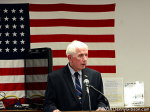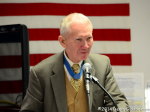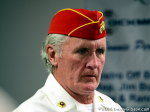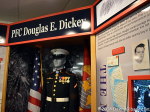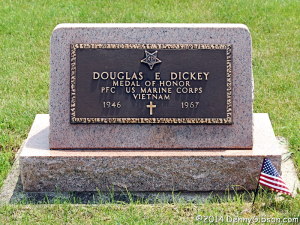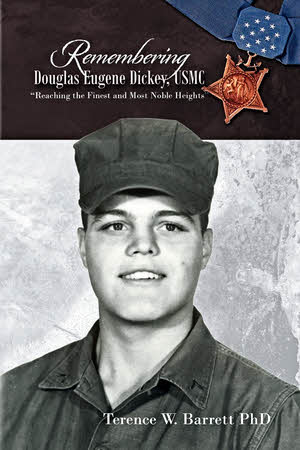 Remembering Douglas Eugene Dickey is something I’ve done for a long time. We were classmates through twelve years of school. We weren’t super close. Not like the teammates on the football squad that broke a thirty-eight game losing streak and not nearly as close as the four other classmates who enlisted in the Marines with him but we were friends. With something like sixty-five students in our graduating class everybody knew everybody. Yes, I’ve been remembering Doug Dickey for a long time.
Remembering Douglas Eugene Dickey is something I’ve done for a long time. We were classmates through twelve years of school. We weren’t super close. Not like the teammates on the football squad that broke a thirty-eight game losing streak and not nearly as close as the four other classmates who enlisted in the Marines with him but we were friends. With something like sixty-five students in our graduating class everybody knew everybody. Yes, I’ve been remembering Doug Dickey for a long time.
I sure learned a lot from this book, though. Some, like details of Doug’s time in the Marines, I expected. Some, like the story of his father’s own time in the Marines, I didn’t. The book paints a very complete picture of Douglas Eugene Dickey’s twenty year long life but it also paints a picture of his family and, to a lesser degree, his country.
Doug died in Viet Nam on Easter Sunday 1967. He died after throwing himself on a grenade to protect those around him. For this he was awarded the Congressional Medal of Honor. His actions were those we naturally connect with the Medal of Honor. They may have basically been the same as others who have covered grenades for their buddies but one of those buddies witnessed something that isn’t often seen. Even though we understand at some level that putting yourself at extreme risk is anything but instinctive, we tend to think of sacrifices like Doug’s as nearly so. I suppose they are to the extent that soldiers often have thought about certain situations and have at least subconsciously considered their own reaction. Doug had no doubt done that but he still had to make a decision in real time. And people saw him make that decision. He saw the grenade, looked at the wounded soldier nearby, then made eye contact with the medic who watched him make that split second decision. Then he dived.
My writing about that dive is hardly a spoiler. If you know anything about the book or about Doug Dickey you know about the Medal of Honor. That dive is the reason this book was written. It takes place on page 656. A few pages describing the remainder of the battle follow. End notes begin on page 737. In between, the story of the medal being approved and presented to Doug’s parents is told and Barrett also covers the funeral, other awards and remembrances, and several reunions of the men with whom Doug served.
Doug and his four classmates enter the Marines on page 330 which means that something on the order of half the book’s content relates to his time in the military. While covering Doug’s activities in some detail, Barrett also provides significant background. I can’t say whether or not his descriptions of some of the events of the 1960s are sufficient to paint a full picture for someone younger than me but I do know they do a good job of reviving tucked away memories. Even before Doug heads to Vietnam, activities there are reported along with his progress stateside. Barrett’s reporting of various battles and other actions is sometimes reminiscent of the body counts that were a feature of the nightly news back in the day. But many of the bodies that Barrett reports have names and most of those names have Ohio addresses. There is an understandable Ohio tilt and even a Darke County tilt to the reporting. Reading about Ohio boys being wounded and dying in Vietnam leaves little doubt about the risks that Doug and his buddies had volunteered for. Doug’s movements and activities “in country” are reported with the same level of detail as his time in training.
So what’s in the other half of the book? Doug’s pre-USMC life is there of course; School days and life on the farm. But the first couple hundred of the book’s pages tell of things from before Douglas Eugene Dickey was even born. Some of the earliest are not even directly connected to him with any certainty. Barrett writes of Dickeys in the military starting with the American Revolution. Peter Dickey, a corporal in the Union Army, was Doug’s great-great-grandfather. Whether or not Peter was a direct descendant of any of fighting Dickeys of earlier generations about whom Barrett writes is not known. I can easily imagine Barrett discovering stories of those early Dickeys then trying and failing to trace the lineage to Doug. There are valid arguments both for and against including these not-quite-connected stories and I initially questioned them myself. But in the end I agreed with their inclusion. This book is not in any way light reading. It resembles a reference book much more than a shallow novel. For Barrett to leave out anything that his research uncovered would not be right.
Of all the fighting Dickeys appearing in this book, I think Doug’s father, Harold, is the most tragic and even heroic. He was in training when his wife died giving birth to a daughter he wouldn’t see until he returned from the south seas at the end of the Second World War. Living through that then losing a son in Vietnam is beyond my understanding. I met Harold a time or two but I knew nothing of his WWII experiences. This book that is ostensibly about Vietnam has something of The Greatest Generation in it, too.
I attended the dedication of the Garst Museum display described in the book. One speaker in particular used phrases like “gave his life for his country”. That’s a view I don’t quite buy into. I never served but not one veteran I’ve ever talked with about it really buys it either. Some noble sense of patriotism may trigger enlisting but on the ground it’s the men around you who matter. Barrett includes a quote from author James Bradley that says this quite succinctly. “They may have fought for their country, but they died for their friends.”
I recommend Remembering Douglas Eugene Dickey, USMC though not to everyone. I’m having trouble defining just who it is I recommend it to. It’s not a light read or a light carry. It’s two inches thick, weighs two and a half pounds, and contains more than 800 pages. Clearly anyone who know Doug Dickey in any way will want to read it. People working at assembling a picture of the Vietnam era will get a big boost from it as will anyone studying the impact of war on a state, a county, or a family. A lot of research went into this book. Producing it is an impressive accomplishment. Though many orders of magnitude less, reading it is not a small undertaking, either.
Remembering Douglas Eugene Dickey, USMC, Terrence W. Barrett, Phd, CreateSpace Independent Publishing Platform, June 20, 2015, paperback, 9 x 6 inches, 826 pages, ISBN 978-1511431149
It should be noted that Dr. Barrett contacted me as he was bringing this book to completion and he has included a few paragraphs about my website and its mentions of Doug toward the book’s end.
Available through Amazon.

 Douglas Dickey never got to be a veteran. He barely got to be a high school graduate. Less than two years after graduation, Doug’s life ended in Vietnam. He was twenty years old.
Douglas Dickey never got to be a veteran. He barely got to be a high school graduate. Less than two years after graduation, Doug’s life ended in Vietnam. He was twenty years old.
